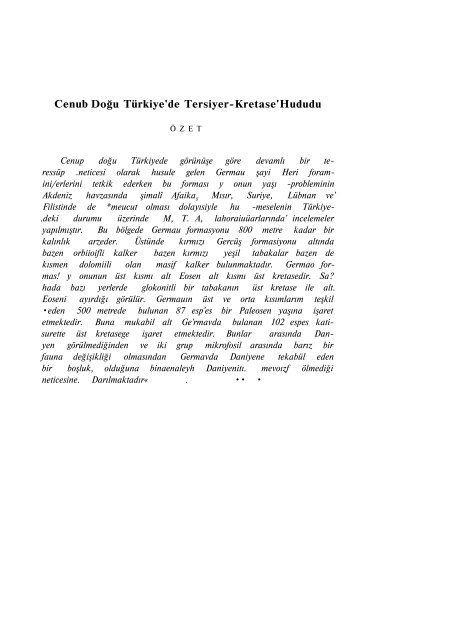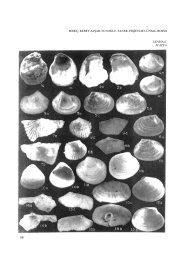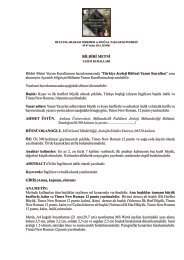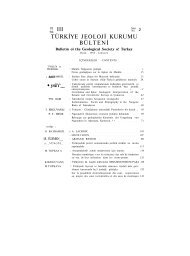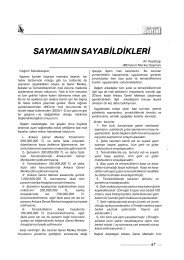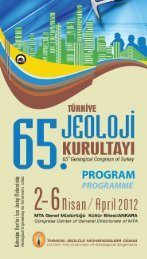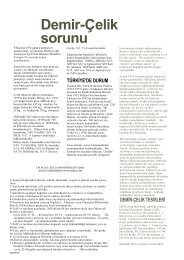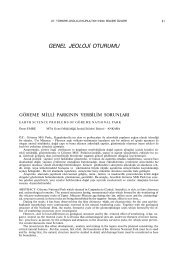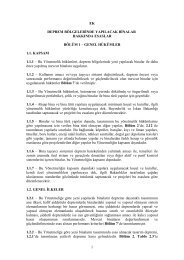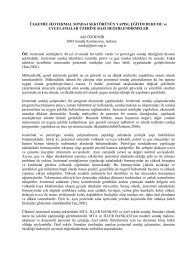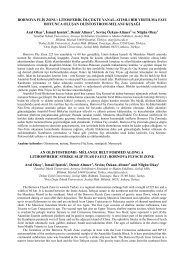Cenub DoÄu Türkiye'de Tersiyer-Kretase'Hududu
Cenub DoÄu Türkiye'de Tersiyer-Kretase'Hududu
Cenub DoÄu Türkiye'de Tersiyer-Kretase'Hududu
Create successful ePaper yourself
Turn your PDF publications into a flip-book with our unique Google optimized e-Paper software.
<strong>Cenub</strong> Doğu Türkiye'de <strong>Tersiyer</strong>-<strong>Kretase'Hududu</strong><br />
ÖZET<br />
Cenup doğu Türkiyede görünüşe göre devamlı bir teressüp<br />
.neticesi olarak husule gelen Germau şayi Heri foramini/erlerini<br />
tetkik ederken bu forması y onun yaşı -probleminin<br />
Akdeniz havzasında şimalî Afaika $<br />
Mısır, Suriye, Lübnan ve'<br />
Filistinde de *meucut olması dolayısiyle hu -meselenin Türkiye-<br />
.deki durumu üzerinde M, T. A, lahoraiuüarlarında' incelemeler<br />
yapılmıştır. Bu bölgede Germau formasyonu 800 metre kadar bir<br />
kalınlık arzeder. Üstünde kırmızı Gercüş formasiyonu altında<br />
bazen orbiioifli kalker bazen kırmızı yeşil tabakalar bazen de<br />
kısmen dolomiili olan masif kalker bulunmaktadır. Germao formas!<br />
y onunun üst kısmı alt Eosen alt kısmı üst kretasedir. Sa?<br />
hada bazı yerlerde glokonitli bir tabakanın üst kretase ile alt.<br />
Eoseni ayırdığı görülür. Germauın üst ve orta kısımlarım teşkil<br />
•eden 500 metrede bulunan 87 esp'es bir Paleosen yaşına işaret<br />
etmektedir. Buna mukabil alt Ge'rmavda bulanan 102 espes katisurette<br />
üst kretasege işaret etmektedir. Bunlar arasında Danyen<br />
görülmediğinden ve iki grup mikrofosil arasında barız bir<br />
fauna değişikliği olmasından Germavda Daniyene tekabül eden<br />
bir boşluk, olduğuna binaenaleyh Daniyenitı. mevoızf ölmediği<br />
neticesine. Darılmaktadır« . •• •
The Cretaceous -Tertiary Boundary.In South- Eastern<br />
Turkey *)<br />
bu A. TEN DAM<br />
I — InterductSon<br />
During the course of a study of the foraminiferal faunafrom<br />
the argillaceous-marly beds of the Germav Formation in, South<br />
Eastern Turkey, formation constitung the Cretaceous - Tertiary<br />
boundary, apparently deposited in continuous sedimedtation, the'<br />
problem has arisen what age must be attributed to these beds,<br />
Since the same problem exists almost everywhere in the mediterranean-<br />
region, as well in Egypt and French -North Africa^ as<br />
the other countries of .the Near. East, and since a definite'solution<br />
of this problem is far from acquired^ it seems useful to present<br />
here a short note on this problem as far as Turkey is cancerned.<br />
The paleontological. study of ' the argiltaceous - marly beds of<br />
the Germav Formation has been executed in the Micropaleoiitological<br />
Laboratory of MTA Enstitüsü at Ankara during the winter<br />
season of 1951-1952 by Dr. A.-ten Dam. A study of the underlying<br />
massive limestones will be done by Dr. A*S, Erk»..<br />
II - Historical<br />
Although there exists a fairly extensive literature on the Ore»<br />
taceous Tertiary boundary in the Mediterranean contries and- in<br />
the Near East ?<br />
only a few details are known on the .microfauna<br />
of these beds and even less has been published on this boundary<br />
in Turkey,<br />
These are mainly Tromp (Lit. 1941, 1942 ?<br />
1943, 1949) and,<br />
Tromp and Mehlika Taşman (Lit. 1942) who published some<br />
details on the age of the transition beds between Cretaceous and<br />
Tertiary in SE Turkey, Tromp gave us some valuable details<br />
on age, nature, and microfauna of these'transition-beds in Ms<br />
1) Paper presenten-d during" the meeting of the Geological Society of<br />
Turkey'on . 20 - 23 February 1952,<br />
2) Senior - Paleontologist MTA Enstitüsü Ankara®
29<br />
-papers and althoug'he certainly well observed the sharp boundary<br />
between the- cretaceous and tertiary microfaunae, his determinations<br />
of the age-of the represented- cretaceous and tertiary<br />
formations have not always been very satisfactory, since Tromp<br />
had no possibility to do any' detailed • scientific paléontologie<br />
analysis. Since • however M.T.A. Enstitüsü has put at our disposition<br />
an extensive micropaleontologic documentation it became<br />
important and also possible to start a detailed study of the foraminiferal<br />
faunae in the Germav Formation, It is only such a<br />
detailed study of the different species of formanifera represented<br />
that could give us an exact idea of the age of these transition<br />
' beds,<br />
III — Geography<br />
The Germav Formation^ discussed in detali in this paper, is<br />
outcropping and has been drilled in the SE of Turkey,' in the<br />
area between Diyarbakır in the W and Cizre to the E, limited<br />
in the N by the ' Bitlis mountains and towards the S by the<br />
Syrian frontier« •<br />
' À general review of the stratigraphy in this region has<br />
been given by 0. E. Taşman '(Lit 1949) and N.. Egeran<br />
(Lşt 1951),<br />
IV — Lithology<br />
It would be extremely difficult, if not impossible to trace the<br />
exact limit between Cretaceous and Tertiary in SE Turkey, if<br />
one had to base this-on lithology only, since there is apparently<br />
no indication of a sedimentation break in the transition beds.<br />
In the field-it is thus almost impossible, in most of the cases, to<br />
draw this limit.<br />
The transition beds from Upper Cretaceous to Tertiary in<br />
SE . Turkey ' are formed by a marly-argillaceous, formation,<br />
known' as Germav Formation. It is a very monotonous complex<br />
of argillaceous marls ?<br />
or silty shales of grey to dark grey colour.<br />
In its upper part there 'are frequently intercalations of sandy<br />
shales and calcareous sandstones. Laterally this upper -part of<br />
the series is interfingering with a more calcareous ..section, the<br />
Becirman Limestones. In the middle part of the Germav Forma-
30 . .<br />
tioıı we generally observe a decrease of sandy and silty intercalations,<br />
locally with some thin limestone intercalations and<br />
towards the base again seme sandy intercalations» The lower part<br />
of this formation is generally more uniformly shaly or silty and<br />
only occasionally shows some sandy horizons. The total thicknes<br />
of the formation may reach well over 800 meters,<br />
The Germav Formation is overlain by redcoloured gypsife*<br />
rous beds, principally composed of sandy shales and claystones,<br />
or argillaceous sands with some limestone - intercalations locally.<br />
The red beds are for the greatest part certainly of continental<br />
origin, whereas ^the limestone-beds represent marine invasions«<br />
This formation is hnown under the name of Gercüş Formation.<br />
The Germav Formation is underlain by soft Orbitoidal limestones,<br />
which overlie red and greem marly beds or directly the<br />
massive partly dolomitle limestones.<br />
In the fieled it is however locally possible to find a sandy glauconitic<br />
bed appoximately indicating the limit between Cretaceous<br />
and Tertiary» Whether this glauconitic bed is a constant feature<br />
or if it is only locally developed is not known with certainty •<br />
It is clear from this short description that there is apparently<br />
no sharp indication for a sedimentation break between Czetaceous<br />
and Tertiary in the monotonous complex of grey shales of the<br />
Germav Formation, although it is possible that the locally observed<br />
glauconitic bed near that limit, represents such a break of<br />
sedimentation»<br />
¥ — Paleontology and Stratigraphy<br />
We have seen that it 'is extremely difficult to. trace any limits<br />
in the monotonous marly series of the Germav Formation.<br />
Tromp contributed greatly to the solution of this difficulty by<br />
proving that it is possible to trace a very distinct limit in this<br />
formation separating Cretaceous from Tertiairy by means of/Mic- •<br />
ropaleontology. Unfortunately Tromp has not been able to- date<br />
exactly these beds ?<br />
since he had not sufficient literature at his<br />
disposition to be able to make a specific analysis of the microfanuae.<br />
His method of quantitative generic microfaunal analysis<br />
is certainly satisfactory for tracing several distinctive<br />
assemblages in the cretaceous and tertiary Germav -. beds; these
assemblages represent by no means • different- stratigraphie<br />
units ş<br />
but simply faciès units. Tromp considered that in the Germav<br />
Formation were included : Middle ' Eocene ?<br />
Lower Eocene<br />
(including Paleocene), Maestrichtian, Oampanian and a- great part<br />
of. Santonian. This stratigraphie conception is not: based .on any<br />
paléontologie evidence as far is concerned specific determinations<br />
and'is decidedly entirely erroneous.<br />
.Since Arni's studies'we know that the limestone intercalations<br />
in the Gercüş Formation, overlying the Germav, are clearly<br />
characterised by the presence of : ' ' •<br />
CAMERINA PARVULA (Cushman) 1919<br />
CAMERINA PRAELÜCASl (Douvillé). 1924<br />
CAMERINA RURDIGALENSIS (de la Harpe) 1926<br />
whereas in other localities has been observed :<br />
LOGKHARTIA CONDITI (Nuttal) 1926<br />
This assemblage of .-Nummulites and Lockhartia proves us<br />
that the, Gercüş Formation cannot be considered as being younger<br />
than Lower Eocene (Ypresiän), all of these species starting<br />
in the Upper Paleocene and typical for the . Lower Eocene« So<br />
we must accept that the Germav Formation is overlain.by Lower<br />
Eocene (Ypresian). ' .<br />
Towards the base we know that the Lower Germav.is overlying<br />
.the soft limeştores containing Orbitoides. These limestones<br />
are characterised by the presence of : • • •<br />
.OMPHALOCYCLÜS MACROPORUS " (Lamarck) 1825<br />
-ORBITOIDES APICTJLATA Schlumberger 1902<br />
ORBITOIDES MEDIA (d'Archiac) 1837 ' . y<br />
This assemblage of larger foraminifera is characteristic all<br />
over the world for the Maestrichtian and perhaps just still for<br />
the- uppermost part of the Campanian. Tromp (Lit. 1941) tried<br />
to prove that these Orbitoids have a much larger vertical ocçurence,<br />
going from the Turonian up into the Maestrichtian,<br />
without any scientific paleontological evidence, Since we find in<br />
Turkey that these Orbitoids are frequently associated with typically<br />
Maestrichtian Globotruncana ? s and since there are no traces<br />
of Turonian pelagic foraminifera in these .beds, we must accept
that the generally accepted conception, that these Orbitoids are<br />
typical for Maestrichtian, is true,- So it must be considered' äs a<br />
fact that the Ğermav ..Formation is overlying * ; beds of Maestrichtian<br />
or Campanian age<br />
With the knowledge that the Ger ma v is overlain by Lower<br />
Eocene (Ypresian) and underlain by Maestrichtian or Upper Campanian<br />
we have to proceed to an analysis of this formation.<br />
Detailed and specific study of the microfaunae from the Germav<br />
in SE Turkey prove us that there exist in this formation<br />
two enirely different • microfaunal units, one belonging to the<br />
Tertiary<br />
?<br />
the other to the Cretaceous, Already Tromp -has diştincly<br />
traced this limit, although his studies were not based on specific<br />
microfaunal analysis«<br />
The Upper and 'Middle parts of the Germav Formation, reaching<br />
a total thickness of over 500 meters^ are characterised by a<br />
microfauna composed of 87 species :<br />
12 o/ o<br />
new species<br />
22 ö/ 0<br />
nomina nuda (due to bad preservation)<br />
43 % species only known from the Paleocene all over the<br />
world '..<br />
10 % species continuing from the Upper Cretaceous<br />
6 o/ o<br />
species continuing into the Eocene<br />
7 % species that are stratigraphically indifferent«<br />
The faunal character is decidedly paleocene. This paleocene<br />
fauna! character would even be still more pronounced if the paleocene<br />
microfaunae from the mediterranean countries would be<br />
better known, since a.great part of the new species are also oeciiring<br />
in the Paleocene of French jtforth Africa«<br />
It might be possible that the top of the Germav with the main<br />
Lockhar-tia - horizon (a new species, of the genus: LOCKHÂRTIÀ<br />
DÂVIESI Ten Dam) belongs already to the Lower Eocene (Ypresian).<br />
The. microfauna of this horizon apart from Lockhartia and<br />
some Miliolids is relatively poor and badly preserved so that it is<br />
difficult to determine exactly its age, although the presence of, pelagic<br />
paleocene foraminifera suggests a paleocene age, Since this<br />
same species of Lockhartia has been observed also deeper in the<br />
.typical Paleocene, it seems better to consider also the main Lockhartia<br />
horizon of the Upper Germav as Paleocene.
The pelagic forms, which have certainly to be cosidered as the<br />
most constant from a stratigraphical point of view, due to their<br />
worldwide distribution and their way of life more apt to rapid<br />
migrations and due to their restricted vertical distribution, are<br />
typically paleocene:<br />
GLOBIGERINA PSEUDOBULLOIDES Plummer 1927<br />
GLOBIGERINA. TRILÖCULINÖIDES Plummer 1927<br />
GLOBOROTAUA ACUTA (Toulmin) 1941<br />
These three pelagic forms, occuring all along the shaly section of<br />
the Upper and Middle Germav, are the typical pelagic index-foraminifera<br />
for the Paleocene of the mediterranean region as well<br />
as for Trinidad., Venezuela and the Southern United States and we<br />
find them equally well represented in the Paleocene of NW Europe<br />
and the Caucasus;<br />
The Upper and Middle Germav must thus be considered 'as<br />
typically of Paleocene age.<br />
On the contrary the Lower Germav ?<br />
reaching thicknesses<br />
over- ŞÖO moters ?<br />
is characterised by an entirely different mic- :<br />
!<br />
rofatına • composed of 102 species : •<br />
9 % new species« • -<br />
21 % nomina nuda (due to bad preservation).<br />
63 % species only recorded from the Upper Cretaceous and<br />
mainly from Maestrichtian or Campanian.<br />
3 o/ o<br />
species continuing into the Paleocene,<br />
, 2 % species continuing into the Econe.<br />
2 % species continuing into the Neogene,<br />
The faunal character is decidedly Upper Cretaceous and even mainly<br />
Maestrichtien or Upper Campanian, only 7 o/ o<br />
of the species<br />
continuing beyond the Cretaceous - Tertiary boundery. As for the<br />
exact age of these beds we will have to refer again principally to<br />
the pelagic elements in the microfauna, because of the stratigraphie<br />
value of these forms and their worldwide distribution. The<br />
Globigerines are represented by :<br />
GLOBIGERINA CRETACEA d'Orbigny 1840 .<br />
GLOBIGERINELLA ASPERA (Eherenberg) 1854<br />
38
34<br />
both species öccuring typically in the Upper Cretaceous beginning<br />
with the Cenomanian. The Globotruncanae, typical incex-fossils<br />
for the Upper Cretaceous, on the contrary show a very cha-<br />
. racteristic assemblage, principally- composed of species with a<br />
simole keel :<br />
GLOBOTRUNCANA STUARTI (de Lapparent) 1918 .<br />
-. GLOBOTRUNCANA CONICA White 1928<br />
GLOBOTRUNCANA ARCA (Cushman) 1926<br />
GLOBOTRUNCANA LUGEONI Tilev 1951-<br />
The occiirence of Globotruncana stuarti and Globotruncana conica,<br />
in numerous specimens all along the lower Germav section proves<br />
that the Lower Germav belongs without any doubt in the<br />
Maestrichtian. The presence of numerous specimens of well developed<br />
Gümbelina's as :<br />
' GÜMBELINA COSTULATA Cushman 1928<br />
GÜMBELINA PLUMMERAE Loetterle 1937 "<br />
GÜMBBLINA ULTIMATUMIPA White' 1928<br />
' is a supplementary proof for the Maestrichtian age of this section.<br />
So it is quite evident from the microfaunae that the Germav<br />
Formation can be divided in a Paleoeene part and a Maestrichtian<br />
part.<br />
In the microfaunae there is no trace whatsoever of Banian*<br />
It is even remarkable that the break Maestrichtian Paleoeene is<br />
such an abrupt one. On the exact boundary we can observe<br />
that from one sample to another almost the entire microfaune<br />
disappears and an entirely new microfauna starts^ alhough'the<br />
lihtologic faciès seem to be exactly the same, It seems to me<br />
extremely difficult to imagine that such an abrupt change of<br />
fauna might be possible without any break in the sedimentation<br />
Although, the formation* is lithologically identical at both sides<br />
of the Cretaceous - Tertiary boundary and one would be tempted<br />
to accept here continuous sedimentation, the microfaunal content<br />
and especially the fundamental break in the microfauna suggests<br />
strongly a more or less important break in the sedimentation,<br />
which., could correspond with the Danian ? not represented in this<br />
part of Turkey,
Elsewhere in the world the Banian constitutes the transitionheels<br />
from Cretaceous to Paleocene, especially from a microfauiiistical<br />
viewpoint; from bottom to top the typically cretaceous<br />
foraminifera as Globotriincana and Giimbelina disappear rapidly,<br />
although the benthome cretaceous forms continue, almost to the<br />
top of the Danian and gradually more and more paleocene foraminifera<br />
begin to occur. These transition-beds are decidedly not<br />
represented in the Germav Formation." In certain parts of North<br />
Africa and the Near East we know beds in between the Maestrichtiaii<br />
and the typical Paleocene with such a transitional fauna,<br />
corresponding with the Danian formation group« If these beds<br />
are not represented in the Germav Formation it becomes rather<br />
probable, notwithstanding the lithologie uniformity, that there<br />
is a break in the sedimentation between Maestrichtian and Paleocene.<br />
This is a very important conclusion for the Near East and<br />
even Nordh Africa where several authors arrived to the conclusion<br />
that there does not exist and never did exist Danian and where<br />
other authors imagine that there is only Danian and no Paleo-<br />
35<br />
¥1 — Comparison With Other Regions ®<br />
In Ms paper on the Cretaceous Tertiary boundary in the<br />
Near East, Tromp poses the thesis that it would be superfluous<br />
to accept the existence of a Danian formation - group for the<br />
Near East and North Africa in the transition beds from the Cretaceous<br />
to the Eocene. In a recent artical on the geologic history<br />
of Egypt Tromp (Lit.. 1951) insists once more on the non-existence<br />
of Denian in the Near East,<br />
We know however in Egypt marly beds overlying the •Maestrichtian<br />
and underlying the Eocene or possibly the Paleocene,<br />
the «Esna» shales, reaching according to Nakkadv (Lit 1950)<br />
thicknesses of several hundreds of meters. In the geological lite<br />
rature on Egypt these beds are generally considered as Danian,<br />
Tromp, denying the existence of Danian, cons iders them as Lower<br />
Eocene or Paldocene. Recently Nakkady .(Lit, 1950) described<br />
the new species of foraminifera from the Esna shales and gave<br />
a list of all the species occuring in these beds» Unfortunately he<br />
did not give a list of the vertical distribution of his species, but<br />
from his text it is sufficiently clear that the typical Cretaceous
36<br />
pelagic forms as Globotruncana and Gümbeliiia disappear almost<br />
at the base of. this formation whereas the rest of the Esna shales<br />
shows a microfauna with numerous benthonic elements of the<br />
Cretaceous mixed with some, paleocene foraminifera. This microfauna,<br />
although apparently in exactly-the same faciès as the Paleocene<br />
of SE Turkey, is nevertheless ; -entirely different from the<br />
microfaunae of the Maestrictian as well as of the Paleocene of<br />
SE Turkey. The pelagic elements are represented by : ' - "<br />
GLOBIGERINA CRETACEA Yar, ESNEHENSIS Nakkady<br />
' 1950<br />
GLOBOROTALIA VELAŞCOENSIS (Oushman) 1927 .<br />
and seems to be closely related to, if not identical withj the microfaunae<br />
of the Danian of North Africa, Trinidad, Mexico and.<br />
and Ihe Caucasus.<br />
:<br />
Marie (Lit. 1949) mentioned a closely related microfauna,<br />
considered by him as Danian, with :<br />
'<br />
GLOBOROTALIA VELAŞCOENSIS (Cushman) 1927<br />
with clear benthonic cretaceous characters, but without Globotruncana<br />
or Gümbeliiia from beds with :<br />
.OSTREA OVERWEGI<br />
• CARDITA BEAÜMONTI ' ^ •<br />
ROUDAIREA DRUl<br />
from North Africa (Morocco) where there is apparently continuous<br />
sedimedtation between Maestrichtian and Yrpesian, Higher<br />
on'these same beds however contain a typical • paleocene microfauna<br />
with : ^ .<br />
GLOBIGERINA PSEUDOBULLOIDES Plumer 1927<br />
GLOBIGERINA TRILLOGULINOIDES'Plummer .1927<br />
GLOBOROTALIA AOUTAT (Toulmin) 1941<br />
and other typically tertiary benthonic elements, formation which<br />
Marie correlates with the Will - Point Formation<br />
;<br />
and the Upper<br />
Midway Formation of the US A, 'as well as with the Paleocene • of<br />
NW Europe.<br />
Hilly and Sigal (Lit. 1951) mentoined; a microfauna similar<br />
to that of marie from Morocco ?<br />
in the beds with Cardita beaumon-
ti in Algeria. Evidently the transition beds of Maestrichtian to<br />
Ypresian in. Morocco and Algeria, characterised • by Gardita bea~<br />
umonti, Ostrea overwegi and Roudairea drui, apperently depposited<br />
in continuous sedimentation according to their lithologie<br />
uniformity, can represent both Danian and Paleocene. In other<br />
parts of Algeria these transition beds in the same faciès are characterised<br />
only by a distinctly paleocene microfauna, as .mentioned<br />
by Sigàf (Lit. 1949) and ten Dam (Lit. 1948), although the<br />
macro.fauna is still characterised by Cardita beaumonti, without<br />
any. trace of a Danian microf auna. Although these beds litholo-"<br />
gically suggest continuous sedimentation from Cretaceous to Eo-<br />
-eene r we must also there accept a break in the sedimentation<br />
between Meastriohtian and Paleocene, corresponding to the Banian,<br />
represented not far from there«<br />
In this comparison with other regions we should not forget<br />
to mention the important paper of Wicher (Lit, 1949) on the Up»<br />
permost Cretaceous of the Tampico. embay ment area of Mexico,<br />
compared with beds of-the same age-in the " Caucasus^ Austria,<br />
Germany and Poland, In this paper Wicher proves the existence-of<br />
a Danian and a Maestrichtian microf auna with world-wide<br />
distribution, both characterised by typical species, the same from<br />
Mexico to the Caucasus. For the Danian it is the microf aunae with:<br />
GLOBOROTALIA -VELASOOENSIS (Cushman) 1927<br />
typical for the Danian of the mediterranean region, with associated<br />
microf auna with still mainly cretaceous character, although<br />
without Globotruncana and Gümbelina and' already with some<br />
paleocene elements» It" is amazing that this microf auna of the<br />
transition-beds from Maestrichtian to Paleocene has such a worldwide<br />
distribution as is-so uniform as suggested by Wicher.<br />
Finally Cushman and Renz (Lit, 1946) described a rich microf<br />
auna from the Lizard Springs Foamation of Trinidad (BWI),<br />
with the same Danian character. •<br />
, It is clear from the preceding pages that there exists a transition<br />
- microfauna 'between the Maestrichtian and the Paleocere<br />
over great parts of the world, considered to be of Danian age.<br />
If this fauna is lacking in the transition .beds on "the Cretaceous<br />
Terfiary boundary in SE Turkey, whereas in neighbouring co-<br />
37
38<br />
untries this fauna may be represented if sedimentation - conditions<br />
were favorable, our conclusion must be that in the Germav<br />
Formation of SE Turkey no Banian is represented, so<br />
that we must accept a break in the sedimentation in this<br />
monotonou sseries.
L İ T E R A T Ü R<br />
1 — J. A. CUSMAN ançi H, H. RENZ : The Foraminiferal fauna of the Lizard<br />
Spring's Formation oî Trinidad BWI - Spec. Publ.<br />
Cushman Lab. For. Res., No. 18- 1946 - pp. 1-48,<br />
pi. 1-8.<br />
2 - A. TEN DAM ı<br />
3 — N. EGERAN :<br />
i - J. HILLY and J.SIGAL :<br />
5 - P. MARIE :<br />
6 — S, E. BAKKADY :<br />
8 - C. E. TAŞMAN :<br />
9 - MEHLIKA TAŞMAN :<br />
10 - MEHLIKA TAŞMAN :<br />
11 — S. W, TROMP :<br />
12 — »<br />
18 _ » » :<br />
Observations sur le o-enre de Forminifères/FCarreria<br />
Rzehak 1891-BulL SGF » Série 5 Vol, 18 - 1948-pp,<br />
285-288,<br />
On the Oil fields .located in S a<br />
E. Turkey - MTA»<br />
Bull« No. 4Ï, 1951. pp. 53-64.<br />
Sur la présence du Seaoııîea Supéaieur dans la<br />
région d'Herbillon ( Cap de Fer - Département de<br />
Constantine ) - Comptes rendus Şomm, SGF - 1951,-<br />
pp. 26 - 28, ' ' ' •<br />
Microfaunes pélagiques des couches "à Carllîa<br />
beaumoati - ibidem 1949 » pp. 241 - 243,<br />
 new formioiferal fauna from the Esna shales<br />
and the Upper Cretaceous Chalk of Egypt - Jonrru<br />
of Pal. f<br />
Vok 24, pt. 6 • 1950 - pp* 675 - 692,<br />
7 - J, SIGAL :<br />
Dano - Montien ou Paléocène ou le paseage de<br />
Crétacé au Tertiaire en Algérie Comptes Rendus<br />
Soram. SGF. 1449 » pp. 150-- 152.<br />
Stratigraphy of SE;Turkey " Bull. AAPG » Vol 33»<br />
1949 •- pp. 22.81,<br />
Preliminary observatioos on Ramaodağ Field Based<br />
OQ Subsurface data I4TA Ng» 4, pp. 50^59 Dec-1950.<br />
Observation on Turkey's Ramandağ* Field Oil<br />
FORU.VL Dec, 1952 pp 8<br />
54 - 56,<br />
The stratigraphical distribution of the genraa Or ra<br />
bitoides aud Omphalocyclus in SE Turkey M META<br />
Bull., ^ene 6, 3/24 - 1941 - pp. 366 - 370.<br />
Priliminary' compilation of the stratigraphy^ structural<br />
features and oil - possibilities öf SE Turkey<br />
and a eomparisoo with neighbouring* areas - MTAE<br />
Pupbl. Ser, S f<br />
No.' 4 Ş<br />
194Î - pp. 1 « 84.<br />
Mierofaunae ot . the Upper Cretaceous and Ter a<br />
tiary sections (Arablae faciès) la the Urfa ?<br />
Gaziantep<br />
regions of S Turkey . MTAE Bull», sene 8,<br />
1/29 . 1943 - pp a<br />
134 - 141.
40<br />
14 — » • > . The Microfaunae of the Lower and MIdd!® Eocene<br />
of Ramandağ- Well No 2 (SE Turkey ) - Ibidem,<br />
§ene 8, 5/30 - 1943 - pp 251 - 253.<br />
15 — » » t The determination of the Cretaceous Eocene boim*<br />
. . dary by means of. quantitative generic rnicrofaunai<br />
determinations ' and the conception Danian in the<br />
Ne East . Journ. of Pal. Vol. 2g, pt. 8, 1949 - pp,<br />
673 . 676«<br />
İ6 — •». » • • The geological history of Egypt and of the Red<br />
Sea In particular w Boll. Geol. Soe® Turkey Vol. 3«<br />
No, 1 - 1951 - pp« 54*96*<br />
17 — » » and M* L TAŞMAf^-: The mierofauaae of the basal E°ceae<br />
and Upper Cretaceous section of Ramandağ Well<br />
No, 2 (SE..Turkey) MTAE Bull., sen© 7 S<br />
1/26»<br />
1942 » pp. 121 » 125.<br />
18 — C, A. WICHER : Oo the age of the higher Upper Cretaceous of<br />
the Tampico embayment area in Mexico f<br />
as an<br />
example of worldwide existence of microfosslls<br />
and the pratieal conséquences arising from . this"<br />
Bull. Mos* Hist, Nat. Pays Serbe » Ser, A. No. 2-*<br />
1949 ».pp, 49 - 105, pi. .1 -8. '"


